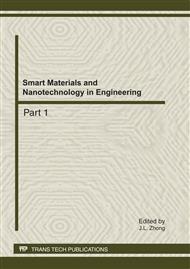p.257
p.263
p.270
p.276
p.280
p.287
p.292
p.297
p.304
Preparation and Microwave Absorption Properties of CNTs/HAp Composites for Use in Tumor Hyperthermia
Abstract:
CNTs/HAp thermo-seed material were prepared by a simple and effective coprecipitation and hydrothermal treatment method. The phase structure, composition and morphology of CNTs/HAp composites were examined by X-ray diffraction (XRD), transmission electron microscope (TEM). The results showed that When CNTs content was 10wt%, after hydrothermal treatment, a certain high degree of crystallinity, pure component single HAp layer was obtained on the surface of CNTs successfully. The electromagnetic parameters of CNTs/HAp composites were measured in the range from 0 GHz to 5.0 GHz. The results showed that CNTs/HAp composite had better absorbing properties in the 0-5.0 GHz range. With increasing of CNTs content, the microwave absorbing capacity of CNTs/HAp composite had been gradually strengthened, the absorption peak moved towards high frequency, the bandwidth was increased. When CNTs content was 8wt%, a maximum reflection loss value of -26 dB had been obtained at 3.0 GHz. Therefore, CNTs/HAp composite material is expected as thermo-seed material for tumor hyperthermia.
Info:
Periodical:
Pages:
280-286
Citation:
Online since:
September 2011
Authors:
Price:
Сopyright:
© 2012 Trans Tech Publications Ltd. All Rights Reserved
Share:
Citation:


